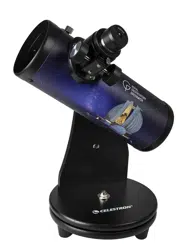Loading ...
Loading ...
Loading ...

12 | ENGLISH
Red Flashlight
This is an essential tool for deep-sky astronomy for reading finder charts or star atlases.
In order to see the faint light coming from distant objects like nebulae or galaxies, your
eyes must be fully dark adapted with your irises fully open to let the most light from your
telescope into them. White light from a standard flashlight will cause your irises to close
down and it can take up to 30 minutes for your eyes to return to full dark adaptation.
Red lights do not have the same effect. We recommend any red LED flashlight that has
adjustable brightness output, because even red light, if excessively bright, can affect
your night vision. We recommend the Celestron PowerTank Glow 5000. It’s the perfect
brightness and can also charge your personal electronics.
Planisphere
A planisphere is a special circular star map that will show you the rough placement
of constellations over your head, so you can navigate your way across the sky. Unlike
charts you can print online, planispheres work at any time of year, not just the date
or month you printed it for. The planisphere consists of two round disks joined at the
center. The bottom disk has a map of the constellations while the top disk has a window
cut into it out showing a portion of the sky map. By turning the inner and outer disks
to match your specific date and time, the map will display only those constellations
visible to you at that time. This is handy for finding rough locations of bright stars and
constellations. Planispheres are available at most bookstores. Be sure to pick one that
is designed for your location, as planispheres correspond to geographical latitudes in
the Northern or Southern Hemispheres.
Star Atlas
Star atlases are the roadmaps of the sky. Once you have located a constellation with
your planisphere, the star atlas will show you a detailed, close-up view of that region
of sky showing the stars and deep-sky objects that reside in it. These are available at
many telescope retailers or bookstores.
Apps and Programs
There are many smartphone and tablet applications that take the place of planispheres
and star maps, including the SkyPortal app from Celestron. These will give digital
representations of the night sky on your device, allowing you to go from a wide view to
a zoomed-in view with a touch of the screen. Try searching your device’s app store to
see what’s available.
There are also some great astronomical sky simulation programs available for your
computer with very detailed on-screen star maps, tools to help you plan an observing
session, and printable star maps customized for your time and location. If you recently
purchased a Celestron telescope, you should have received a code for a free download
of Celestron’s Starry Night astronomy software.
You have now viewed the Moon and planets. It’s time to take the next step on your journey to the cosmos and look for
your first objects beyond our Solar System.
DEEP-SKY OBSERVING EQUIPMENT
HOW TO FIND DEEP-SKY OBJECTS
Loading ...
Loading ...
Loading ...
